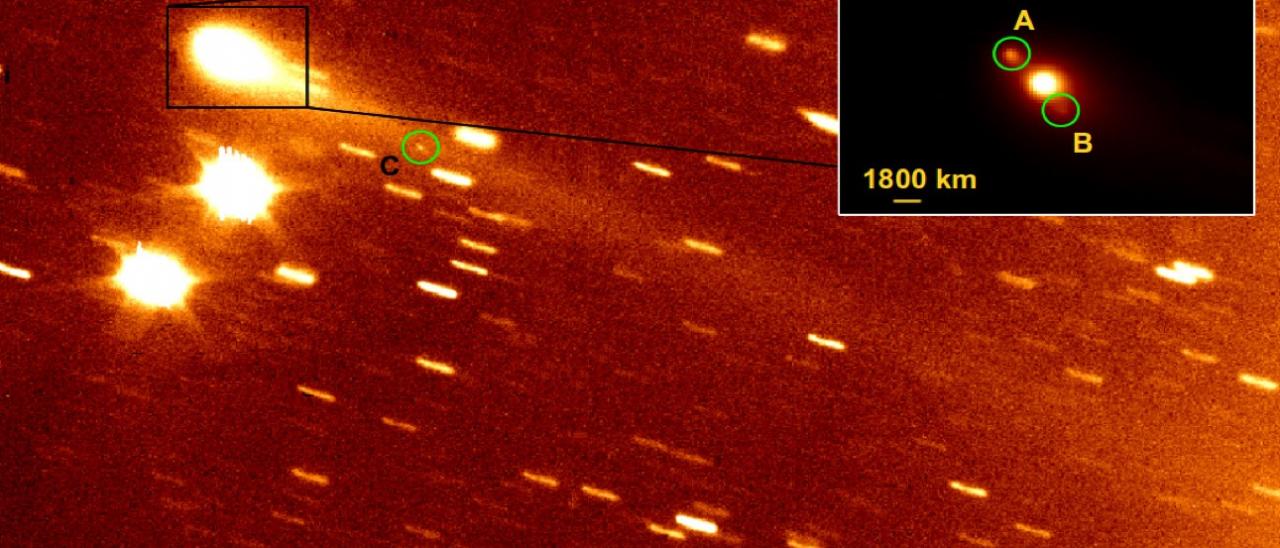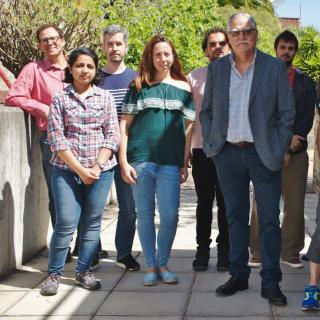Subvenciones relacionadas:
General
Este Proyecto estudia las propiedades físicas y composicionales de los llamados pequeños cuerpos del Sistema Solar, que incluyen asteroides, objetos helados y cometas. Entre los grupos de mayor interés destacan los objetos trans-neptunianos (TNOs), incluyendo los objetos más lejanos detectados hasta la fecha (Extreme-TNOs o ETNOs); los cometas, y los objetos transicionales cometa-asteroide (Centauros y los llamados Main Belt Comets - MBCs); los asteroides primitivos. Los dos últimos grupos contienen el material más primordial y prístino del Sistema Solar son claves para comprender su origen y evolución. Se destacan entre los asteroides aquellos que se acercan a la órbita de la Tierra (near-Earth asteroids o NEAs), así como los considerados potencialmente peligrosos (Potentially Hazardous Asteroids o PHAs). Debido a su cercanía, los NEAs son los objetos más accesibles al estudio in-situ con misiones espaciales y su futura explotación como fuente de materias primas (asteroid mining). Se destaca el liderazgo por parte del IP del grupo de un survey espectroscópico (visible e infrarrojo cercano) de asteroids primitivos (PRIMitive Asteroid Spectroscopic Survey - PRIMASS). Este proyecto ha recibido financiación de la NASA (17-PDART17_2-0097, IP: N. Pinilla-Alonso, 137.000€ - 2 años) para archivar todos estos espectros (más de 800) en el Small Bodies Node del NASA Planetary Data System.
Los estudios de composición superficial y propiedades físicas y térmicas de estos cuerpos se llevan a cabo utilizando espectroscopia en un amplio rango de longitudes de onda (desde 0.35 a 24 micras), así como imagen y fotometría en el mismo rango. Los datos se interpretan utilizando modelos de scattering y termo-físicos. El proyecto trabaja además en el análisis de las propiedades físicas de los núcleos cometarios y de las propiedades del polvo y el gas en las comas cometarias, muy especialmente en el estudio del polvo en las colas de los MBCs y de los mecanismos por los cuales se emite.
Este grupo mantiene diversas colaboraciones internacionales con otros grupos entre las que podemos destacar: (1) la pertenencia al Grupo de Ciencia de la misión de NASA OSIRIS-REx, en concreto al "Image Processing Working Group", en donde se encarga del tratamiento de los mapas de color que se están obteniendo actualmente con las cámaras OCAMS; (2) la pertenencia al núcleo central de proponentes de las misiones M5 de ESA CASTALIA, CASTAway y Hera; (3) la coordinación de un grupo internacional de estudio de NEAs llamado EURONEAR (European Near Earth Asteroid Research); (4) la pertenencia al "Center for Lunar and Asteroid Surface Science" (CLASS, NASA); (5) la integración en el grupo de Sistema Solar de la misión Euclid; (6) la participación activa en los surveys J-PLUS y J-PASS, en los que trabaja en la explotación de las observaciones de objetos del Sistema Solar; (7) la pertenencia a los grupos de trabajo de Sistema Solar de los telescopios Gaia y JWST.
Miembros
Actividad científica
Publicaciones relacionadas
-
High-resolution observations of bright boulders on asteroid Ryugu: 1. Size frequency distribution and morphology
The near-Earth asteroid (162173) Ryugu displays a Cb-type average spectrum and a very low average normal albedo of 0.04. Although the majority of boulders on Ryugu have reflectance spectra and albedo similar to the Ryugu average, a small fraction of boulders exhibit anomalously high albedo and distinctively different spectra. A previous study
Sugimoto, Chiho et al.Fecha de publicación:
112021 -
Geologic History and Crater Morphology of Asteroid (162173) Ryugu
Crater morphology and surface age of asteroid (162173) Ryugu are characterized using the high-resolution images obtained by the Hayabusa2 spacecraft. Our observations reveal that the abundant boulders on and under the surface of the rubble-pile asteroid affect crater morphology. Most of the craters on Ryugu exhibit well-defined circular depressions
Cho, Y. et al.Fecha de publicación:
82021 -
Dust environment of active asteroids P/2019 A4 (PANSTARRS) and P/2021 A5 (PANSTARRS)
We report on the characterization of the dust activity and dynamical evolution of two faint active asteroids, P/2019 A4, and P/2021 A5, observed with the 10.4 m GTC using both imaging and spectroscopy. Asteroid P/2019 A4 activity is found to be linked to an impulsive event occurring some ±10 d around perihelion, probably due to a collision or a
Moreno, Fernando et al.Fecha de publicación:
92021 -
Spectral diversity of the inner belt primitive asteroid background population
We present new near-infrared spectra of 55 objects observed using the NASA InfraRed Telescope Facility and the Telescopio Nazionale Galileo, along with visible spectra of 21 objects obtained from the SMASS and S 3OS 2 surveys, to explore the differences in spectral slope and curvature between the background and the families and to show that the
Arredondo, Anicia et al.Fecha de publicación:
112021 -
Regional Photometric Modeling of Asteroid (101955) Bennu
We present a regional photometric analysis of asteroid (101955) Bennu, using image data from the MapCam color imager of the OSIRIS-REx Camera Suite (OCAMS). This analysis follows the previously reported global photometric analysis of Bennu, which found that Bennu's roughness was difficult to photometrically model owing to unresolved surface
Golish, D. R. et al.Fecha de publicación:
82021 -
Natural Night Sky Brightness during Solar Minimum
In 2018, Solar Cycle 24 entered into a solar minimum phase. During this period, 11 million zenithal night sky brightness (NSB) data were collected at different dark sites around the planet, including astronomical observatories and natural protected areas, with identical broadband Telescope Encoder and Sky Sensor photometers (based on the Unihedron
Alarcon, Miguel R. et al.Fecha de publicación:
72021 -
Development of image texture analysis technique for boulder distribution measurements: Applications to asteroids Ryugu and Itokawa
Recent asteroid missions have revealed that many sub-kilometer asteroids are rubble piles. Large parts of their surfaces are covered with boulders larger than tens of centimeters. An evaluation of the abundance and size distribution of boulders provides clues to understand surface processes on boulder-covered asteroids. Here we report a new method
Tanabe, Naoya et al.Fecha de publicación:
92021 -
Activity of the Jupiter co-orbital comet P/2019 LD<SUB>2</SUB> (ATLAS) observed with OSIRIS at the 10.4 m GTC
Context. The existence of comets with heliocentric orbital periods close to that of Jupiter (i.e., co-orbitals) has been known for some time. Comet 295P/LINEAR (2002 AR 2) is a well-known quasi-satellite of Jupiter. However, their orbits are not long-term stable, and they may eventually experience flybys with Jupiter at very close range, close
Licandro, J. et al.Fecha de publicación:
62021 -
Resurfacing processes on asteroid (162173) Ryugu caused by an artificial impact of Hayabusa2's Small Carry-on Impactor
The resurfacing process on Ryugu accompanying the artificial impact crater formation by Hayabusa2's Small Carry-on Impactor (SCI) was studied by comparing pre- and post-impact images of this region captured by an optical navigation camera. Three different aspects of the resurfacing process were examined: the crater rim profiles, the motion of
Honda, Rie et al.Fecha de publicación:
92021 -
The active centaur 2020 MK<SUB>4</SUB>
Context. Centaurs go around the Sun between the orbits of Jupiter and Neptune. Only a fraction of the known centaurs have been found to display comet-like features. Comet 29P/Schwassmann-Wachmann 1 is the most remarkable active centaur. It orbits the Sun just beyond Jupiter in a nearly circular path. Only a handful of known objects follow similar
de la Fuente Marcos, C. et al.Fecha de publicación:
52021 -
The EURONEAR Lightcurve Survey of Near Earth Asteroids—Teide Observatory, Tenerife, 2015
One meter class telescopes could bring important contributions in the acquisition of lightcurves of near earth asteroids (NEAs), based on which rotations and other physical properties could be derived or constrained. Part of a collaboration between IAC, ESA and the EURONEAR during the semester 2015A, the IAC80 and OGS telescopes at Teide
Vaduvescu, O. et al.Fecha de publicación:
102021 -
Alignment determination of the Hayabusa2 laser altimeter (LIDAR)
In this study, we determined the alignment of the laser altimeter aboard Hayabusa2 with respect to the spacecraft using in-flight data. Since the laser altimeter data were used to estimate the trajectory of the Hayabusa2 spacecraft, the pointing direction of the altimeter needed to be accurately determined. The boresight direction of the receiving
Noda, Hirotomo et al.Fecha de publicación:
122021 -
Bennu's global surface and two candidate sample sites characterized by spectral clustering of OSIRIS-REx multispectral images
The OSIRIS-REx spacecraft encountered the asteroid (101955) Bennu on December 3, 2018, and has since acquired extensive data from the payload of scientific instruments on board. In 2019, the OSIRIS-REx team selected primary and backup sample collection sites, called Nightingale and Osprey, respectively. On October 20, 2020, OSIRIS-REx successfully
Rizos, J. L. et al.Fecha de publicación:
82021 -
Numerical modeling of lander interaction with a low-gravity asteroid regolith surface. II. Interpreting the successful landing of Hayabusa2 MASCOT
Context. The JAXA asteroid sample return mission Hayabusa2 reached its target (162173) Ryugu in June 2018 and released the European (CNES-DLR) lander MASCOT in October 2018. MASCOT successfully landed on the surface, and the Hayabusa2 Optical Navigation Camera system has been able to image parts of the MASCOT trajectory. Aims: This work builds on
Thuillet, Florian et al.Fecha de publicación:
42021 -
Improved method of hydrous mineral detection by latitudinal distribution of 0.7-μm surface reflectance absorption on the asteroid Ryugu
Global multiband images of the C-type asteroid (162173) Ryugu were obtained by the optical navigation camera telescope (ONC-T) onboard Hayabusa2. The 0.7-μm absorption depth of the surface reflectance spectrum, which indicates the presence of hydrous minerals, was not clearly seen on Ryugu using flat field correction data obtained in the preflight
Kameda, Shingo et al.Fecha de publicación:
52021 -
Post-arrival calibration of Hayabusa2's optical navigation cameras (ONCs): Severe effects from touchdown events
Accurate measurements of the surface brightness and its spectrophotometric properties are essential for obtaining reliable observations of the physical and material properties of planetary bodies. To measure the surface brightness of Ryugu accurately, we calibrated the optical navigation cameras (ONCs) of Hayabusa2 using both standard stars and
Kouyama, Toru et al.Fecha de publicación:
52021 -
Photometry of asteroid (101955) Bennu with OVIRS on OSIRIS-REx
NASA's OSIRIS-REx spacecraft arrived at its sampling target, asteroid (101955) Bennu, in December 2018 and started a series of global observation campaigns. Here we investigate the global photometric properties of Bennu as observed by the OSIRIS-REx Visible and InfraRed Spectrometer (OVIRS) over the time period December 9, 2018, to September 26
Zou, Xiao-Duan et al.Fecha de publicación:
42021 -
Disk-resolved photometric modeling and properties of asteroid (101955) Bennu
OSIRIS-REx (Origins, Spectral Interpretation, Resource Identification, and Security-Regolith Explorer) is a NASA mission to return a sample of asteroid (101955) Bennu. Photometric modeling of Bennu's surface is a key element of both sample site characterization and our broader scientific understanding of the asteroid. Bennu's heterogeneous surface
Golish, D. R. et al.Fecha de publicación:
32021 -
Near-infrared spectroscopy of the Sulamitis asteroid family: Surprising similarities in the inner belt primitive asteroid population
We present NIR spectra of 19 asteroids in the Sulamitis family as part of our survey of primitive inner belt asteroid families. The spectra were obtained with NASA's Infrared Telescope Facility and the Telescopio Nazionale Galileo between January 2017 and February 2020. We find spectral homogeneity in our sample despite the diversity within the
Arredondo, Anicia et al.Fecha de publicación:
42021 -
Collisional history of Ryugu's parent body from bright surface boulders
The asteroid (162173) Ryugu and other rubble-pile asteroids are likely re-accumulated fragments of much larger parent bodies that were disrupted by impacts. However, the collisional and orbital pathways from the original parent bodies to subkilometre rubble-pile asteroids are not yet well understood 1-3. Here we use Hayabusa2 observations to show
Tatsumi, E. et al.Fecha de publicación:
02021



